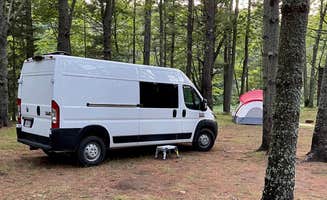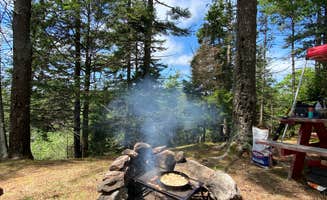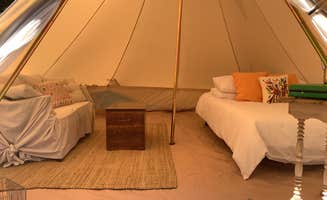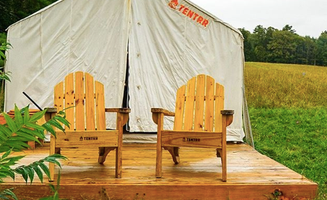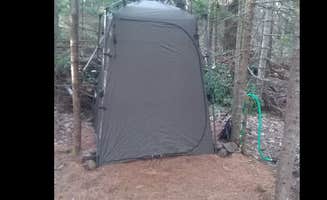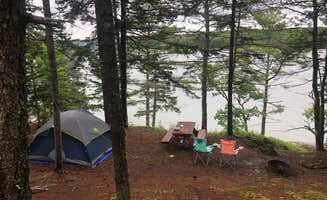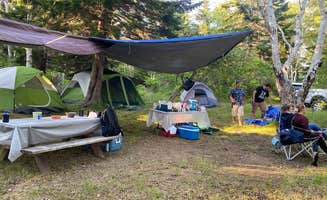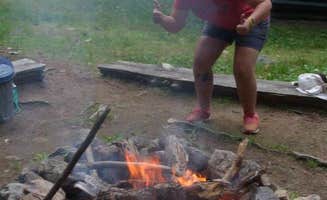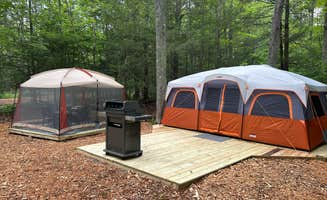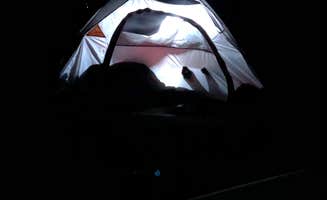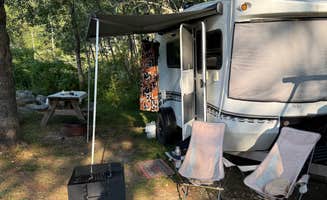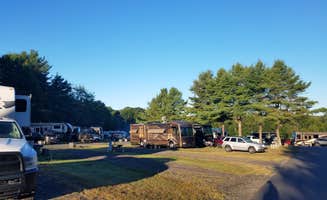The coastal region around West Bath sits at the confluence of Casco Bay and the Kennebec River, creating a diverse landscape of peninsulas and inlets. Most camping sites near West Bath, Maine are located between 10 and 50 feet above sea level, with mixed evergreen and deciduous forest coverage providing natural shelter. Summer temperatures typically range from 55-80°F with coastal fog occurring frequently in the early mornings.
What to do
Kayaking at tidal waterways: At Sagadahoc Bay Campground, campers can explore the changing shoreline with the tides. "When the tide goes out you have the entire inlet to walk around in and explore. At night the stars were absolutely amazing!" notes Michael H. The tidal range exceeds 9 feet in some locations, creating unique paddling opportunities at different times of day.
Visit working farms: The 626-acre property at Wolfe's Neck Oceanfront Campground combines camping with agricultural education. "This campground is located on an organic dairy farm. There is a farm cafe on site with local food," shares Tonya M. The farm offers daily educational tours where visitors can learn about sustainable agriculture practices.
Hiking coastal trails: Many campgrounds maintain trail networks with ocean views. "The hiking trails are fantastic, they range from short to long. All relatively easy. They all have great sights, especially the one along the rocky coast," writes one reviewer about trails at Hermit Island. Most trails are under 3 miles and suitable for all fitness levels with proper footwear.
What campers like
Waterfront access: Campers consistently praise sites with direct water views and access. "We spent the night in one of the Oceanfront RV spots. The RV spots are in a very open field, but they are directly on the water," explains a visitor at Sagadahoc Bay Campground. These premium sites typically cost $5-15 more per night than standard sites.
Fresh seafood options: Many campgrounds offer on-site seafood purchases. "What an amazing campground right on the ocean. we had such a blast here. clamming and floating in with the tide. Fresh lobsters cooked and delivered to our campsite.. Who could ask for anything more in ocean front camping," shares Chrisdin D. about their experience at Sagadahoc Bay.
Clean facilities: Modern bathhouses receive high praise at several locations. "The bathrooms were really nice although I did not use the showers as we have a travel trailer," notes Marje F. about Shore Hills Campground & RV Park. Most campgrounds provide coin-operated showers that typically require quarters for hot water.
What you should know
Reservation systems vary widely: Some campgrounds maintain traditional booking methods. "This campground does not have an online reservation system. You have to mail in your request or call. When calling during the 'winter' months (anytime from September through Mid-June), staff can only be reached from 9:00-2:00," explains one camper about Hermit Island Campground.
Insects can be problematic: Mosquitoes and seasonal pests affect camping comfort. "Even as seasoned campers, they were too much and due to bugs, we ended up leaving a day early," shares one camper. Some visitors recommend Thermacell units for protection, while others use screen tents during peak bug season from late May to early August.
Cell service limitations: Communication access varies significantly. "Absolutely NO CELL SERVICE. Sounds like a good thing, right? Nope. Not for us because in case of emergency, couldn't call anyone for help. Had to drive about a mile out to get reception," notes one camper about their experience. Verizon typically offers the most reliable coverage in coastal areas.
Tips for camping with families
Beach access options: Some campgrounds offer multiple beach environments. "We biked everywhere--since there isn't much parking at the swimming spot," shares Rita M. about getting around. Chewonki Campground receives praise for its salt water pool: "Kayaking, salt water pool and scenic walking trails blends in with the variety of singing birds under several tall pine trees," writes Cheryl R.
Educational activities: Farm-based campgrounds provide learning opportunities. "The camp ground has a farm, campground and state park all together! There are tenting spots, camper spots and field spots," shares one family. Many locations offer junior ranger programs or naturalist-led activities during peak summer season.
Playground facilities: Play areas provide entertainment for younger campers. "Great playground for kids and convenient locations of bath houses. An enjoyable camping experience close to home," notes Nancy G. Most campgrounds with playgrounds position them centrally, within easy walking distance of camping areas.
Tips from RVers
Electrical hookup considerations: RV campers should plan for varied electrical setups. "The electrical hook ups are like 1 box for every 10 camping spots so they r kinda far away so make sure u have an extension cord of some sort," advises Shannon M. about Thomas Point Beach and Campground. Extension cords of at least 50 feet are recommended for many sites.
Site leveling challenges: Terrain varies considerably across the region. "Site 18 was not level and we had difficulty leveling our small motorhome," notes Lisa W. about Desert of Maine Campground. Bringing leveling blocks is essential at many campgrounds, especially those with sites on slopes or natural terrain.
Water fill options: Many campgrounds have limited hookups. "There's no water or sewer hook ups so fill ur water tank before parking," advises one RVer. Fresh water fill stations are typically available near campground entrances, though some locations restrict their use during drought conditions.


